
Over 16,557,306 people are on fubar.
What are you waiting for?


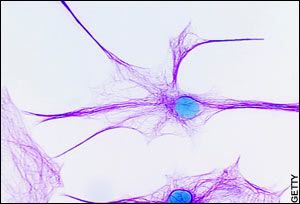 It is increase in the number of synapses in larger animals that allows more sophisticated thought
For decades, men have gloated over how they have bigger brains, and thus must be smarter, a simple side effect of how they tend to have bigger bodies.
Now female intuition that this is simplistic, misleading, even just plain wrong, has been found by new research on the evolutionary origins of the brain and how it evolved into the remarkably complex structure found in humans.
The research in the journal Nature Neuroscience by Professor Seth Grant, Head of the Genes to Cognition Programme at the Wellcome Trust Sanger Institute, suggests that it is not size alone that gives more brain power.
Instead, he found that, during evolution, increasingly sophisticated molecular processing of nerve impulses - notably by providing more connections in the brain - allowed development of animals with more complex behaviours.
"We are one step closer to understanding the logic behind the complexity of human brains," he said.
advertisement
Current thinking suggests that the protein components of nerve connections - called synapses - are similar in most animals from humble worms to humans and that it is increase in the number of synapses in larger animals that allows more sophisticated thought.
But this has been challenged by the study done at the Sanger Institute, with colleagues at Edinburgh and Keele Universities.
"Our simple view that 'more nerves' is sufficient to explain 'more brain power' is simply not supported by our study," explained Professor Grant.
"Although many studies have looked at the number of synapses, none has looked at the molecular composition of synapses. We found dramatic differences in the numbers of proteins in the synapses between different species.
"We studied around 600 proteins that are found in mammalian synapses and were surprised to find that only 50 percent of these are also found in invertebrate (creatures without a backbone, such as insects) synapses, and about 25 percent are in single-cell animals, which obviously don't have a brain.
"The number and complexity of proteins in the synapse first exploded when multicellular animals emerged, some billion years ago. A second wave occurred with the appearance of vertebrates, perhaps 500 million years ago"
Since the evolution of complex, 'big' synapses occurred before the emergence of large brains, it may be that these molecular evolutionary events were necessary to allow evolution of the human brain..
"The molecular evolution of the synapse is like the evolution of computer chips - the increasing complexity has given them more power and those animals with the most powerful chips can do the most," continues Professor Grant.
Synapses are the junctions between nerves where electrical signals from one cell are transferred through a series of biochemical switches to the next.
However, synapses are not simply soldered joints, but mini-processors that give the nervous systems the property of learning and memory. Remarkably, the study shows that the origins of thinking like in feeling: some of the proteins involved in synapse signalling and learning and memory are found in yeast, where they act to respond to signals from their environment, such as stress due to limited food or temperature change.
"It is amazing how a process of Darwinian evolution by tinkering and improvement has generated, from a collection of sensory proteins in yeast, the complex synapse of mammals associated with learning and cognition," said Dr Richard Emes, Lecturer in Bioinformatics at Keele University, and joint first author on the paper.
It is increase in the number of synapses in larger animals that allows more sophisticated thought
For decades, men have gloated over how they have bigger brains, and thus must be smarter, a simple side effect of how they tend to have bigger bodies.
Now female intuition that this is simplistic, misleading, even just plain wrong, has been found by new research on the evolutionary origins of the brain and how it evolved into the remarkably complex structure found in humans.
The research in the journal Nature Neuroscience by Professor Seth Grant, Head of the Genes to Cognition Programme at the Wellcome Trust Sanger Institute, suggests that it is not size alone that gives more brain power.
Instead, he found that, during evolution, increasingly sophisticated molecular processing of nerve impulses - notably by providing more connections in the brain - allowed development of animals with more complex behaviours.
"We are one step closer to understanding the logic behind the complexity of human brains," he said.
advertisement
Current thinking suggests that the protein components of nerve connections - called synapses - are similar in most animals from humble worms to humans and that it is increase in the number of synapses in larger animals that allows more sophisticated thought.
But this has been challenged by the study done at the Sanger Institute, with colleagues at Edinburgh and Keele Universities.
"Our simple view that 'more nerves' is sufficient to explain 'more brain power' is simply not supported by our study," explained Professor Grant.
"Although many studies have looked at the number of synapses, none has looked at the molecular composition of synapses. We found dramatic differences in the numbers of proteins in the synapses between different species.
"We studied around 600 proteins that are found in mammalian synapses and were surprised to find that only 50 percent of these are also found in invertebrate (creatures without a backbone, such as insects) synapses, and about 25 percent are in single-cell animals, which obviously don't have a brain.
"The number and complexity of proteins in the synapse first exploded when multicellular animals emerged, some billion years ago. A second wave occurred with the appearance of vertebrates, perhaps 500 million years ago"
Since the evolution of complex, 'big' synapses occurred before the emergence of large brains, it may be that these molecular evolutionary events were necessary to allow evolution of the human brain..
"The molecular evolution of the synapse is like the evolution of computer chips - the increasing complexity has given them more power and those animals with the most powerful chips can do the most," continues Professor Grant.
Synapses are the junctions between nerves where electrical signals from one cell are transferred through a series of biochemical switches to the next.
However, synapses are not simply soldered joints, but mini-processors that give the nervous systems the property of learning and memory. Remarkably, the study shows that the origins of thinking like in feeling: some of the proteins involved in synapse signalling and learning and memory are found in yeast, where they act to respond to signals from their environment, such as stress due to limited food or temperature change.
"It is amazing how a process of Darwinian evolution by tinkering and improvement has generated, from a collection of sensory proteins in yeast, the complex synapse of mammals associated with learning and cognition," said Dr Richard Emes, Lecturer in Bioinformatics at Keele University, and joint first author on the paper.

 A new patent granted to Lockheed Martin seeks to combine multiple lasers into a single, higher-power beam, which would, in theory, help achieve the power output needed for laser weapons. The patent outlines a method to "combine multiple laser beams into a single coherent beam without requiring insertion of optical elements into the laser beam."
A new patent granted to Lockheed Martin seeks to combine multiple lasers into a single, higher-power beam, which would, in theory, help achieve the power output needed for laser weapons. The patent outlines a method to "combine multiple laser beams into a single coherent beam without requiring insertion of optical elements into the laser beam."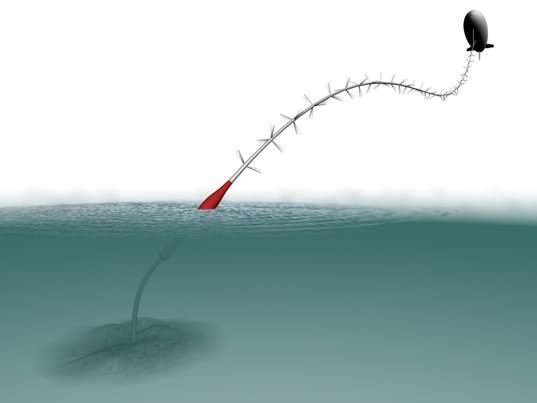 Flying wind-turbines for max power, Selsam Floating Wind Turbines, Flying Wind Turbines, Flying wind power, Selsam floating wind power, wind blimps, flying windmills, flying wind, renewable energy, green tech, clean tech, greener gadgets, Selsam Superturbine, super turbine
The higher up in the air you go, the faster wind travels - so naturally the further from the ground a wind-turbines gets, the more efficient it can be. Thats why the idea of a flying wind-turbine is a such a win-win (or win-wind) proposition. Combining wind power with floating blimps, Selsam has been hard at work expanding the horizons of alternative energy with a revolutionary new breed of SuperTurbines that promise to take wind power to new heights.
Flying wind-turbines for max power, Selsam Floating Wind Turbines, Flying Wind Turbines, Flying wind power, Selsam floating wind power, wind blimps, flying windmills, flying wind, renewable energy, green tech, clean tech, greener gadgets, Selsam Superturbine, super turbine
The higher up in the air you go, the faster wind travels - so naturally the further from the ground a wind-turbines gets, the more efficient it can be. Thats why the idea of a flying wind-turbine is a such a win-win (or win-wind) proposition. Combining wind power with floating blimps, Selsam has been hard at work expanding the horizons of alternative energy with a revolutionary new breed of SuperTurbines that promise to take wind power to new heights.
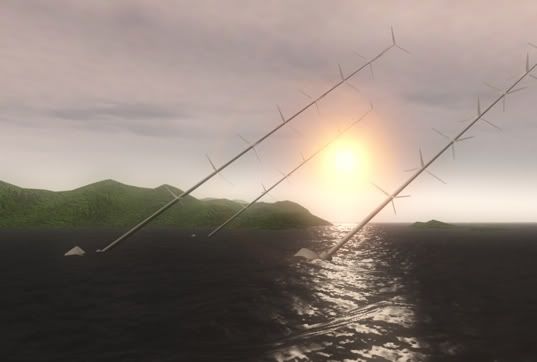 Flying wind-turbines for max power, Selsam Floating Wind Turbines, Flying Wind Turbines, Flying wind power, Selsam floating wind power, wind blimps, flying windmills, flying wind, renewable energy, green tech, clean tech, greener gadgets, Selsam Superturbine, super turbine
Resembling a field of wind-swept reeds swaying on the horizon, these floating wind spires boast an ultra-efficient design that flexes with the wind, taking advantage of air currents along the length of their shaft to generate electricity. Selsam’s prototypes produce 6000 watts in 32.5 mph winds - six times more power than a similarly sized seven foot single-rotor turbine can produce. The turbines can be easily deployed by land and by sea, and their effectiveness can be amplified even further via an air-born blimp.
We’re currently at a bottleneck in the wind turbine pipeline, with GE reporting that it is unable to make turbines fast enough to meet demand. It’s no wonder, since the largest turbines have a propeller size that surpasses the wingspan of commercial airliners and require an intricately machined gearbox. This amounts to a time and resource-intensive engineering and assembly process that has production struggling to deliver on a $12 billion backlog of orders.
Flying wind-turbines for max power, Selsam Floating Wind Turbines, Flying Wind Turbines, Flying wind power, Selsam floating wind power, wind blimps, flying windmills, flying wind, renewable energy, green tech, clean tech, greener gadgets, Selsam Superturbine, super turbine
Resembling a field of wind-swept reeds swaying on the horizon, these floating wind spires boast an ultra-efficient design that flexes with the wind, taking advantage of air currents along the length of their shaft to generate electricity. Selsam’s prototypes produce 6000 watts in 32.5 mph winds - six times more power than a similarly sized seven foot single-rotor turbine can produce. The turbines can be easily deployed by land and by sea, and their effectiveness can be amplified even further via an air-born blimp.
We’re currently at a bottleneck in the wind turbine pipeline, with GE reporting that it is unable to make turbines fast enough to meet demand. It’s no wonder, since the largest turbines have a propeller size that surpasses the wingspan of commercial airliners and require an intricately machined gearbox. This amounts to a time and resource-intensive engineering and assembly process that has production struggling to deliver on a $12 billion backlog of orders.
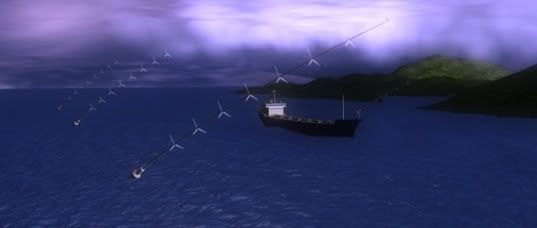 Flying wind-turbines for max power, Selsam Floating Wind Turbines, Flying Wind Turbines, Flying wind power, Selsam floating wind power, wind blimps, flying windmills, flying wind, renewable energy, green tech, clean tech, greener gadgets, Selsam Superturbine, super turbine
Selsam’s SuperTurbines offer an innovative approach to the problem with a scaled-down system of multi-rotor stalks that are extremely versatile, more efficient, and cheaper and easier to produce than than large lumbering windmills. The design relies upon economy of scale to maximize efficiency, employing multiple rotors along a lightweight, flexible shaft that allows it to shift and move with wind currents. Since the turbines rotate at higher rpms than traditional turbines, a small and light direct-drive generator can be used instead of a hulking gearbox.
Selsam’s most recent designs are optimized for sea deployment and consist of a rotor-studded shaft stemming from a floating base that is anchored to the ocean floor. The system is designed so that turbine’s base rotates similarly to the human spine, thus the turbines won’t twist and spin out of control. In an ingenious answer to stormy weather, the turbine’s base can fill with water, submerging it safely beneath the ocean’s surface.
Flying wind-turbines for max power, Selsam Floating Wind Turbines, Flying Wind Turbines, Flying wind power, Selsam floating wind power, wind blimps, flying windmills, flying wind, renewable energy, green tech, clean tech, greener gadgets, Selsam Superturbine, super turbine
Selsam’s SuperTurbines offer an innovative approach to the problem with a scaled-down system of multi-rotor stalks that are extremely versatile, more efficient, and cheaper and easier to produce than than large lumbering windmills. The design relies upon economy of scale to maximize efficiency, employing multiple rotors along a lightweight, flexible shaft that allows it to shift and move with wind currents. Since the turbines rotate at higher rpms than traditional turbines, a small and light direct-drive generator can be used instead of a hulking gearbox.
Selsam’s most recent designs are optimized for sea deployment and consist of a rotor-studded shaft stemming from a floating base that is anchored to the ocean floor. The system is designed so that turbine’s base rotates similarly to the human spine, thus the turbines won’t twist and spin out of control. In an ingenious answer to stormy weather, the turbine’s base can fill with water, submerging it safely beneath the ocean’s surface.
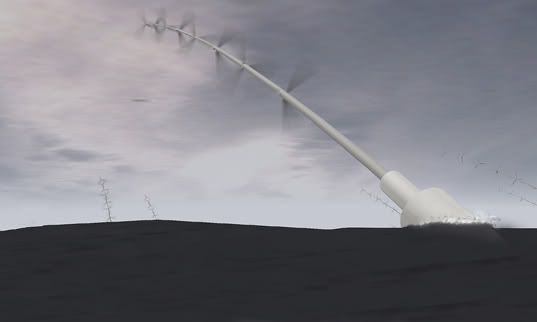 Flying wind-turbines for max power, Selsam Floating Wind Turbines, Flying Wind Turbines, Flying wind power, Selsam floating wind power, wind blimps, flying windmills, flying wind, renewable energy, green tech, clean tech, greener gadgets, Selsam Superturbine, super turbine
In addition to producing energy, the multiple rotors act in unison to keep each stalk afloat; if you’re in need of a visual metaphor, Selsam’s website supplies them in spades: “Like a flock of geese, each rotor favorably affects the next in line. Like a set of louvres, the tilted rotors pull in fresh wind from above, deflecting their wakes downward to insure fresh wind for succeeding rotors and, like a stack of kites, to add overall lift which helps support the driveshaft against gravity and downwind thrust forces. The rotors act as gyroscopes or spinning tops, stabilizing the driveshaft where they are attached.”
When we recently wrote about Sunhope’s solar balloons, many people suggested that they take advantage of wind energy as well. It turns out that Selsam is one step ahead of the game with this exciting technology. Let’s just hope they find a way to negate the turbines’ ominous implication as potential bird blenders.
Flying wind-turbines for max power, Selsam Floating Wind Turbines, Flying Wind Turbines, Flying wind power, Selsam floating wind power, wind blimps, flying windmills, flying wind, renewable energy, green tech, clean tech, greener gadgets, Selsam Superturbine, super turbine
In addition to producing energy, the multiple rotors act in unison to keep each stalk afloat; if you’re in need of a visual metaphor, Selsam’s website supplies them in spades: “Like a flock of geese, each rotor favorably affects the next in line. Like a set of louvres, the tilted rotors pull in fresh wind from above, deflecting their wakes downward to insure fresh wind for succeeding rotors and, like a stack of kites, to add overall lift which helps support the driveshaft against gravity and downwind thrust forces. The rotors act as gyroscopes or spinning tops, stabilizing the driveshaft where they are attached.”
When we recently wrote about Sunhope’s solar balloons, many people suggested that they take advantage of wind energy as well. It turns out that Selsam is one step ahead of the game with this exciting technology. Let’s just hope they find a way to negate the turbines’ ominous implication as potential bird blenders.
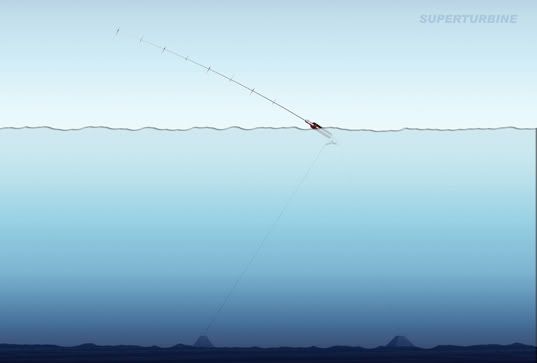

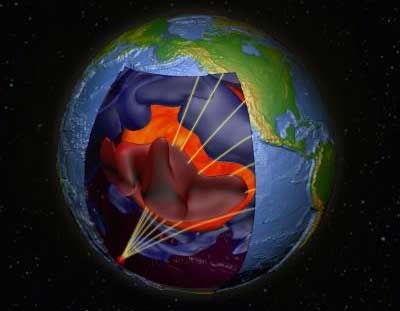 Red and blue regions depict zones where seismic waves propagate slower or faster than average, respectively. Distant earthquakes (e.g., the red star) send seismic energy throughout the planet, which traverses anomalous structure and brings information about Earth’s internal structure to the planet’s surface. The large red region beneath the Pacific Ocean sits atop the hot molten iron core (orange ball), is best explained as chemically distinct from the rest of the mantle. Credit: AAAS/Science
Full Size
Previous Image Next Image
1 of 1
Red and blue regions depict zones where seismic waves propagate slower or faster than average, respectively. Distant earthquakes (e.g., the red star) send seismic energy throughout the planet, which traverses anomalous structure and brings information about Earth’s internal structure to the planet’s surface. The large red region beneath the Pacific Ocean sits atop the hot molten iron core (orange ball), is best explained as chemically distinct from the rest of the mantle. Credit: AAAS/Science
You know Earth's schematic: core, mantle, crust, right? Sorry, not so simple.
Like the gooey center of a chocolate morsel harboring peanut butter and honey, inner Earth is far more nuanced than outward appearances would suggest. A new model is proposed in the May 2 issue of the journal Science.
Earth is made up of several layers, once thought to be pretty distinct.
The skin, or crust, goes down about 25 miles (40 km). Below that is the mantle area, which extends about halfway to the center of the planet. The mantle is a thick layer of silicate rock surrounding a dense, iron-nickel core, and it is subdivided into the upper and lower mantle, extending to a depth of about 1,800 miles (2,900 km). The outer core is beneath that and extends to 3,200 miles (5,150 km) and the inner core to about 4,000 miles (6,400 km).
New data reveal the mantle consists of more varying material than was thought. So convection — how heated material bubbles up — is now thought to work differently.
"Imagine a pot of water boiling," explains researcher Allen McNamara of Arizona State University. "That would be all one kind of composition. Now dump a jar of honey into that pot of water. The honey would be convecting on its own inside the water and that's a much more complicated system."
One clue to the new thinking is that seismic waves traveling through the planet have long been measured to travel at inexplicably different speeds. Sharp speed changes suggest differing materials. On each side of the planet there are two big, chemically distinct, dense piles or blobs of material that are hundreds of kilometers thick – one beneath the Pacific and the other below the Atlantic and Africa, the researchers say.
"You can picture these piles like peanut butter," McNamara said. "It is solid rock, but rock under very high pressures and temperatures becomes soft like peanut butter, so any stresses will cause it to flow."
How stuff moves within the piles should help scientists better understand how surface plates move around, causing earthquakes and building mountains.
"The piles dictate how the convective cycles happen, how the currents circulate," McNamara said. "If you don't have piles then convection will be completely different.
Red and blue regions depict zones where seismic waves propagate slower or faster than average, respectively. Distant earthquakes (e.g., the red star) send seismic energy throughout the planet, which traverses anomalous structure and brings information about Earth’s internal structure to the planet’s surface. The large red region beneath the Pacific Ocean sits atop the hot molten iron core (orange ball), is best explained as chemically distinct from the rest of the mantle. Credit: AAAS/Science
Full Size
Previous Image Next Image
1 of 1
Red and blue regions depict zones where seismic waves propagate slower or faster than average, respectively. Distant earthquakes (e.g., the red star) send seismic energy throughout the planet, which traverses anomalous structure and brings information about Earth’s internal structure to the planet’s surface. The large red region beneath the Pacific Ocean sits atop the hot molten iron core (orange ball), is best explained as chemically distinct from the rest of the mantle. Credit: AAAS/Science
You know Earth's schematic: core, mantle, crust, right? Sorry, not so simple.
Like the gooey center of a chocolate morsel harboring peanut butter and honey, inner Earth is far more nuanced than outward appearances would suggest. A new model is proposed in the May 2 issue of the journal Science.
Earth is made up of several layers, once thought to be pretty distinct.
The skin, or crust, goes down about 25 miles (40 km). Below that is the mantle area, which extends about halfway to the center of the planet. The mantle is a thick layer of silicate rock surrounding a dense, iron-nickel core, and it is subdivided into the upper and lower mantle, extending to a depth of about 1,800 miles (2,900 km). The outer core is beneath that and extends to 3,200 miles (5,150 km) and the inner core to about 4,000 miles (6,400 km).
New data reveal the mantle consists of more varying material than was thought. So convection — how heated material bubbles up — is now thought to work differently.
"Imagine a pot of water boiling," explains researcher Allen McNamara of Arizona State University. "That would be all one kind of composition. Now dump a jar of honey into that pot of water. The honey would be convecting on its own inside the water and that's a much more complicated system."
One clue to the new thinking is that seismic waves traveling through the planet have long been measured to travel at inexplicably different speeds. Sharp speed changes suggest differing materials. On each side of the planet there are two big, chemically distinct, dense piles or blobs of material that are hundreds of kilometers thick – one beneath the Pacific and the other below the Atlantic and Africa, the researchers say.
"You can picture these piles like peanut butter," McNamara said. "It is solid rock, but rock under very high pressures and temperatures becomes soft like peanut butter, so any stresses will cause it to flow."
How stuff moves within the piles should help scientists better understand how surface plates move around, causing earthquakes and building mountains.
"The piles dictate how the convective cycles happen, how the currents circulate," McNamara said. "If you don't have piles then convection will be completely different. Both Qatar's oil minister and the head of OPEC can see oil hitting $200 a barrel before the end of the year and one analyst says gas could reach $7 a gallon within four years. That could mean cataclysm for the global economy.
The world got a little relief today when BP reopened its North Sea pipeline. But the price of gas is averaging $3.60 a gallon and the price of oil is flirting with $120 a barrel with no relief in sight. Market forces don't seem to be functioning in their normal order. OPEC controls only about half of the world's oil supply. Ordinarily, when prices spike skyward, the world's non-cartel spigots open wide. Why isn't this happening and who's to blame?
Oil Companies. Admittedly, obscenely compensated oil executives are laying low these days. Big Oil is rolling in profits. The Bush Administration's tax subsidies to oil companies, which were intended to prod exploration, should infuriate commuters. And yet the profit margins of oil giants are only slightly higher than the average for the S&P 500. And much of the wealth from these companies is pumped back into the economy in dividends, employment, capital spending and the like. Big Oil shouldn't get a walk (and windfall profit taxes make more sense than ever). But it's only a small part of the problem.
China and India. It seems to be a global fact that an automobile signals your arrival into the middle class. Without question, demand for oil in these countries is putting an inexorable upward push on gas prices. This isn't going to change in your lifetime, and it should sound the alarm for North Americans and Europeans that their middle-class lives will be threatened unless they develop alternative forms of energy -- fast. But the increasing demand for oil in China and India is a long-term, slow slope trajectory. It doesn't explain recent spikes. And in the short term, it's self correcting. As oil prices spike, economies slow and the demand for oil eases. So does its price.
Ben Bernanke. Oil is currently priced in U.S. dollars. The Federal Reserve has feverishly tried to calm credit markets in recent months with lower interest rates, which are a kind of Valium for bankers. As interest rates drop, so does the value of the dollar. So it takes more dollars to buy a barrel of oil. Without question, the credit crisis is a more pressing concern than high gas prices. Credit, after all, is the life blood of an economy. It is widely expected that tomorrow the Feds will reduce interest rates again. But many analysts believe this is the last cut we'll see for a while. Fighting inflation -- including rising gasoline prices -- is becoming a priority. When interest rates begin inching up again, it will be bad news if you're taking out a car loan, good news at the pump. In the meantime, just be glad you don't have Ben Bernanke's job.
Speculators. It's never a good omen when fear swallows reason on the trading floor. But this seems to explain part of what's happening with the price of oil. Or maybe it's just greed. Whatever. The good news is that these speculative frenzies tend to end quickly. And ultimately, it's traders' fingers that get burned, not consumers.
Suppliers. Here's the mysterious missing piece in high gas prices: Saudi Arabia, Kuwait, Qatar and other OPEC members try to keep supplies tight and prices high. But England, Norway, Russia and other non-OPEC countries open the spigots to take advantage of high prices. This usually brings prices down. But supply disruptions have become rife -- even with OPEC countries, such as Nigeria, thanks to an insurgency that keeps shutting down its pipeline. Norway's production has dropped by 25 percent since its peak in 2001. Britain's has dropped by 43 percent. Alaska's Prudhoe Bay has dropped by 65 percent from its peak. Russia's is down and so is Mexico's. It's enough to make you think speculators are on to something.
When does fear resemble reason?
Photo by John Perkins.
Both Qatar's oil minister and the head of OPEC can see oil hitting $200 a barrel before the end of the year and one analyst says gas could reach $7 a gallon within four years. That could mean cataclysm for the global economy.
The world got a little relief today when BP reopened its North Sea pipeline. But the price of gas is averaging $3.60 a gallon and the price of oil is flirting with $120 a barrel with no relief in sight. Market forces don't seem to be functioning in their normal order. OPEC controls only about half of the world's oil supply. Ordinarily, when prices spike skyward, the world's non-cartel spigots open wide. Why isn't this happening and who's to blame?
Oil Companies. Admittedly, obscenely compensated oil executives are laying low these days. Big Oil is rolling in profits. The Bush Administration's tax subsidies to oil companies, which were intended to prod exploration, should infuriate commuters. And yet the profit margins of oil giants are only slightly higher than the average for the S&P 500. And much of the wealth from these companies is pumped back into the economy in dividends, employment, capital spending and the like. Big Oil shouldn't get a walk (and windfall profit taxes make more sense than ever). But it's only a small part of the problem.
China and India. It seems to be a global fact that an automobile signals your arrival into the middle class. Without question, demand for oil in these countries is putting an inexorable upward push on gas prices. This isn't going to change in your lifetime, and it should sound the alarm for North Americans and Europeans that their middle-class lives will be threatened unless they develop alternative forms of energy -- fast. But the increasing demand for oil in China and India is a long-term, slow slope trajectory. It doesn't explain recent spikes. And in the short term, it's self correcting. As oil prices spike, economies slow and the demand for oil eases. So does its price.
Ben Bernanke. Oil is currently priced in U.S. dollars. The Federal Reserve has feverishly tried to calm credit markets in recent months with lower interest rates, which are a kind of Valium for bankers. As interest rates drop, so does the value of the dollar. So it takes more dollars to buy a barrel of oil. Without question, the credit crisis is a more pressing concern than high gas prices. Credit, after all, is the life blood of an economy. It is widely expected that tomorrow the Feds will reduce interest rates again. But many analysts believe this is the last cut we'll see for a while. Fighting inflation -- including rising gasoline prices -- is becoming a priority. When interest rates begin inching up again, it will be bad news if you're taking out a car loan, good news at the pump. In the meantime, just be glad you don't have Ben Bernanke's job.
Speculators. It's never a good omen when fear swallows reason on the trading floor. But this seems to explain part of what's happening with the price of oil. Or maybe it's just greed. Whatever. The good news is that these speculative frenzies tend to end quickly. And ultimately, it's traders' fingers that get burned, not consumers.
Suppliers. Here's the mysterious missing piece in high gas prices: Saudi Arabia, Kuwait, Qatar and other OPEC members try to keep supplies tight and prices high. But England, Norway, Russia and other non-OPEC countries open the spigots to take advantage of high prices. This usually brings prices down. But supply disruptions have become rife -- even with OPEC countries, such as Nigeria, thanks to an insurgency that keeps shutting down its pipeline. Norway's production has dropped by 25 percent since its peak in 2001. Britain's has dropped by 43 percent. Alaska's Prudhoe Bay has dropped by 65 percent from its peak. Russia's is down and so is Mexico's. It's enough to make you think speculators are on to something.
When does fear resemble reason?
Photo by John Perkins.